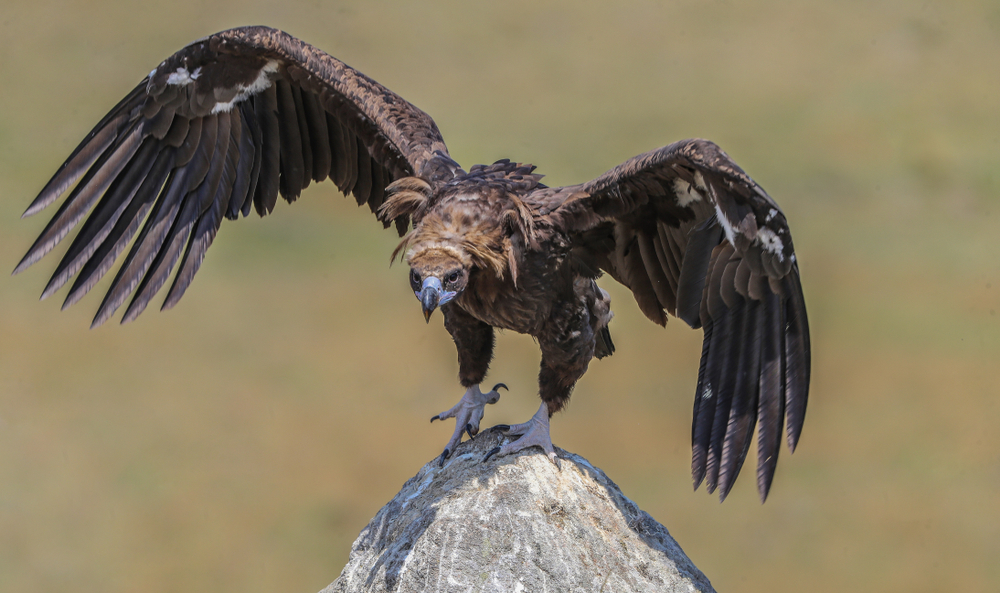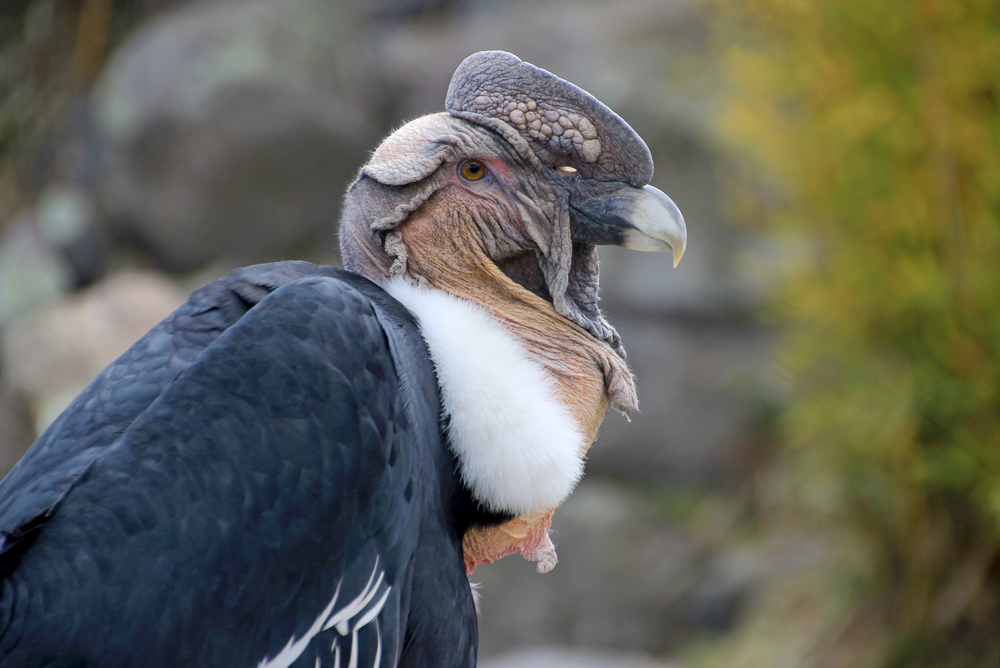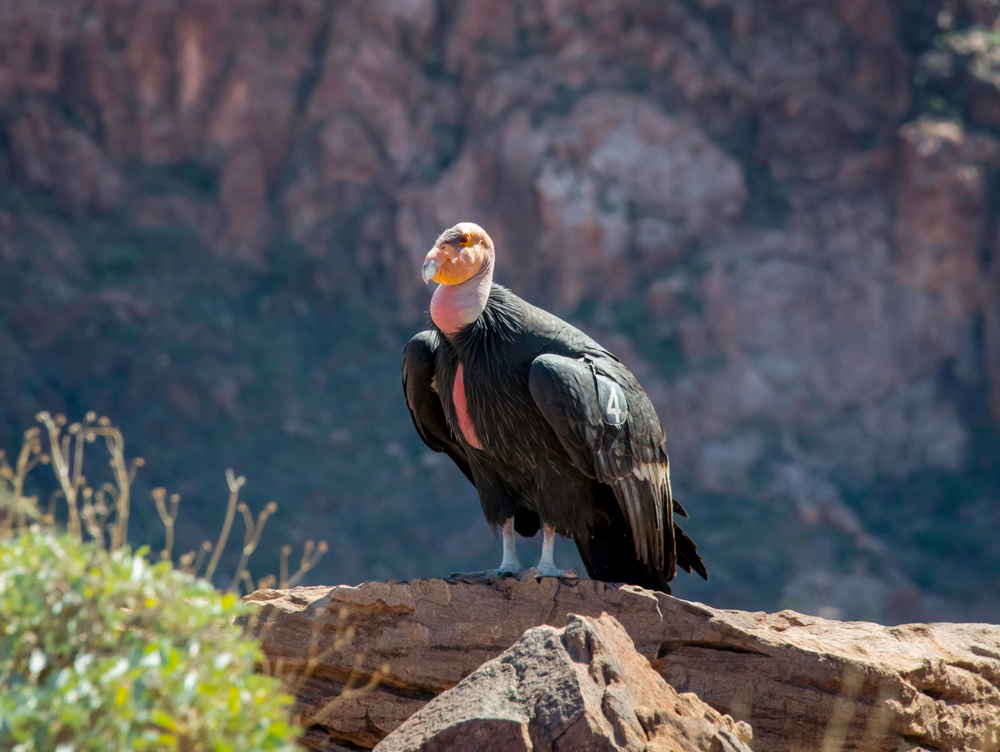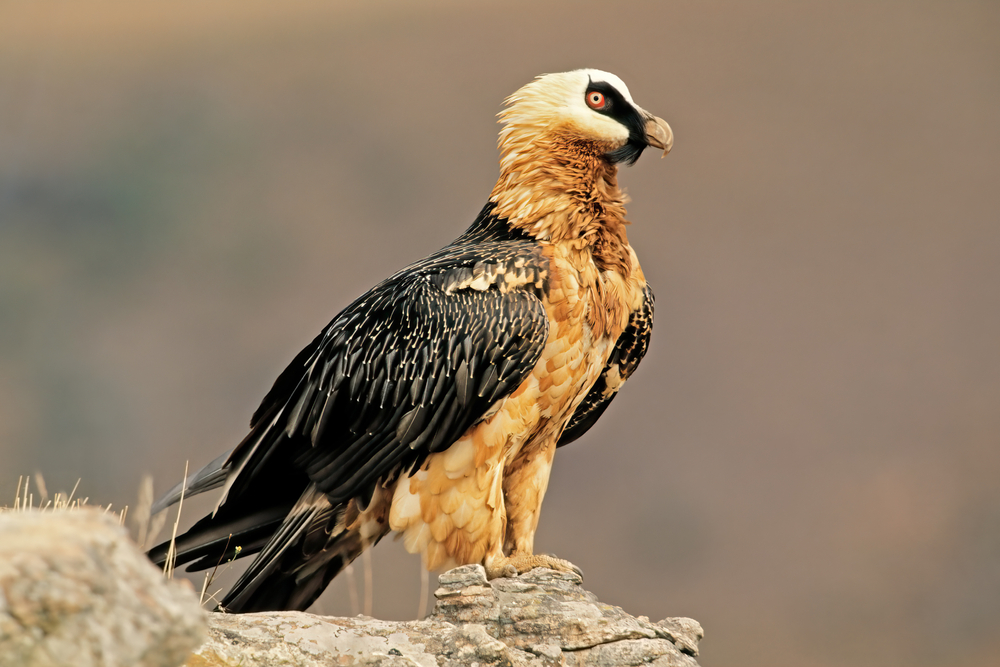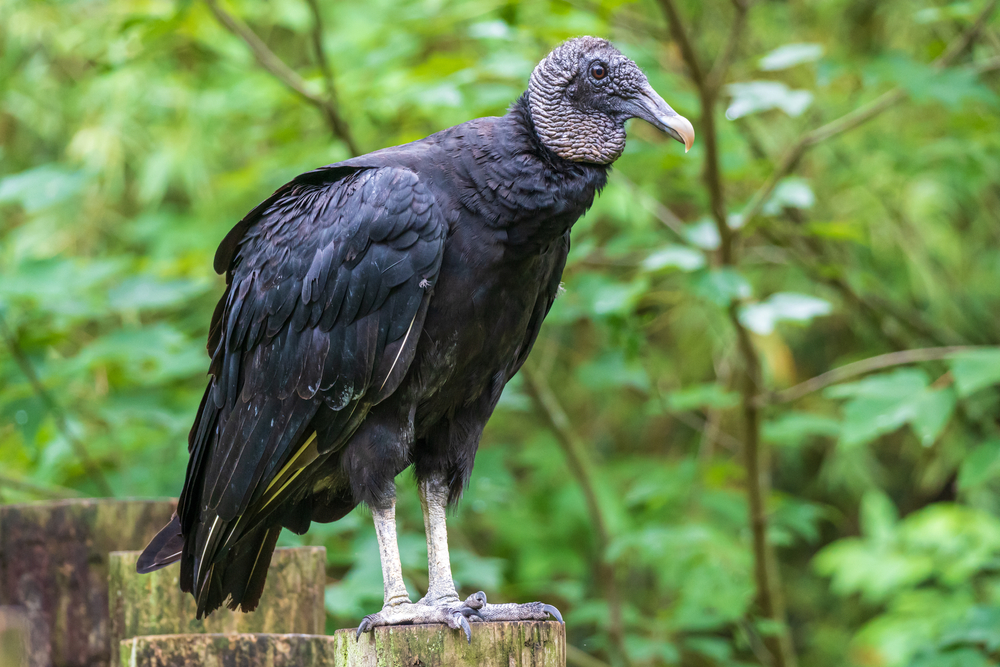The Eurasian Black Vulture (Aegypius monachus) is most closely related to the Lappet-faced Vulture (Torgos tracheliotos) of Africa. Both are massive, dark-plumaged vultures with powerful beaks adapted to tearing through thick hides.
About
The Eurasian Black Vulture (Aegypius monachus), also called the Cinereous Vulture, is a massive Old World vulture belonging to the Accipitridae family. Native to southern Europe and Asia, this imposing bird is one of the heaviest and largest raptors in the world. Its presence in mountainous and forested regions highlights its role as a keystone scavenger, helping maintain ecological balance by cleaning up carrion.
With a wingspan of 2.5–3.1 meters (8.2–10.2 ft) and weighing between 7–14 kg (15–31 lbs), the Cinereous Vulture rivals the Andean Condor in sheer bulk. Its plumage is dark brown to blackish, with a shaggy collar of feathers around the neck and a large, powerful bill adapted for tearing flesh. Its bare bluish-gray head allows it to feed hygienically on carcasses, while its broad wings enable effortless soaring over long distances.
The diet of this species consists almost entirely of carrion, especially the remains of large mammals such as deer, livestock, and wild ungulates. While capable of overpowering weak or newborn animals, it primarily serves as a scavenger, recycling nutrients and preventing the spread of disease.
Breeding takes place in remote, undisturbed areas, often in colonies. Nests are large stick platforms built in tall trees or on cliffs. The female usually lays a single egg, with both parents sharing incubation and chick-rearing duties. The chick fledges after about four months but remains dependent on its parents for weeks afterward.
Historically persecuted and poisoned, populations of Cinereous Vultures declined drastically in the 20th century. Today, conservation initiatives in Spain, the Caucasus, and Central Asia, including reintroduction projects and poison control measures, have helped restore numbers. Although still classified as Near Threatened, the species is slowly recovering, standing as a powerful emblem of wilderness and resilience across Eurasia.
Physical Characteristics
The Eurasian Black Vulture (Aegypius monachus), also known as the Cinereous Vulture, is one of the largest Old World vultures and among the heaviest flying birds.
Plumage:
-
Adults: Dark brown to blackish overall, appearing almost black at a distance. Flight feathers are slightly darker, with paler brown tones on the head and neck.
-
Juveniles: Similar in appearance but usually darker and less contrasting, with a more uniform chocolate-brown plumage.
Head and Face:
The head and upper neck are mostly bare, covered with bluish-gray skin and fine dark down. A distinctive thick ruff of dark feathers encircles the lower neck. The beak is massive, pale at the base, and sharply hooked at the tip, suited for tearing through tough hides.
Body and Wings:
The body is bulky and powerful, with exceptionally broad wings designed for soaring on thermal currents. Their flight is steady and deliberate, less graceful but more imposing than lighter vultures.
Tail:
The tail is relatively short, wedge-shaped, and broad, helping stabilize their heavy body in flight.
Size:
-
Length: 39–47 in (100–120 cm)
-
Wingspan: 8.2–10.2 ft (2.5–3.1 m)
-
Height at Rest: About 3.6 ft (1.1 m) when standing
Weight:
-
Adults: 17–31 lbs (7.5–14 kg), with females typically larger than males.
The Cinereous Vulture’s massive size, dark plumage, and imposing presence make it one of the most powerful scavengers of Eurasia. Its strong beak and broad wings distinguish it as a dominant feeder at carcasses, often displacing smaller vultures.
Reproduction
The Eurasian Black Vulture (Aegypius monachus) has a slow reproductive cycle typical of long-lived raptors, producing only one chick per year and investing heavily in parental care.
1. Mating and Courtship:
Cinereous Vultures are monogamous and often form lifelong pair bonds. Courtship includes aerial displays, synchronized soaring, and mutual preening at nest sites.
2. Nesting Sites:
They build large nests in remote areas, typically in tall trees such as pines or oaks, or occasionally on cliff ledges. Nests are constructed of large sticks and can measure 6–8 ft (1.8–2.5 m) across and reused for many years.
3. Egg Laying:
The female lays a single egg per clutch, usually between February and April, depending on latitude and climate. Eggs are whitish with light speckling.
4. Incubation:
Incubation lasts about 50–55 days, shared by both parents, though the female usually takes the longer shifts.
5. Hatching and Care of Chicks:
The chick hatches covered in white down, fully dependent on its parents. Both parents feed it through regurgitation. Growth is slow, as the species is large-bodied and develops gradually.
6. Fledging and Independence:
Young vultures fledge at about 100–115 days old but remain dependent on parents for several additional months, learning flight skills and feeding behavior.
7. Breeding Frequency:
Eurasian Black Vultures raise one chick per year, though if a breeding attempt fails, they will not lay a replacement egg until the following season.
The Cinereous Vulture’s reliance on a single offspring, large stick nests, and long parental care makes conservation of nesting sites and territories critical for maintaining stable populations.
Lifespan
The Eurasian Black Vulture (Aegypius monachus) is among the longest-lived raptors, with survival shaped by its slow maturity and low reproductive rate.
Lifespan in the Wild:
In the wild, Cinereous Vultures typically live 30–40 years, with some reaching 45 years under favorable conditions. However, many juveniles do not survive their first years due to food scarcity, predation, or human threats.
Lifespan in Captivity:
With reliable food, veterinary care, and protection, individuals can live up to 50–55 years, making them one of the longest-lived vulture species in managed care.
Threats to the Cinereous Vulture:
-
Poisoning: Accidental ingestion of poisoned carcasses or lead fragments from hunting ammunition is a leading cause of mortality.
-
Habitat Loss: Deforestation reduces nesting trees, particularly in Europe and Asia.
-
Persecution: Historically hunted due to misconceptions about livestock predation.
-
Food Availability: Declines in wild ungulates and changing pastoral practices reduce carrion supply.
-
Collisions: Power line strikes and wind turbines are increasing risks.
The Cinereous Vulture’s long lifespan and slow reproduction make it especially vulnerable to population decline, as the loss of adult birds has a disproportionate impact on recovery.
Eating Habits
The Eurasian Black Vulture (Aegypius monachus) is a powerful scavenger, relying almost entirely on carrion. Its massive size and strength allow it to dominate feeding sites.
Diet:
-
Large Mammals: Primary diet includes carcasses of wild ungulates such as deer, ibex, and wild boar, as well as domestic livestock.
-
Smaller Animals: Will also feed on carcasses of rabbits, hares, and smaller birds when available.
-
Bones and Skin: Capable of consuming tougher parts of carcasses, including skin, cartilage, and bones, that smaller scavengers cannot manage.
Hunting Strategy:
-
Scavenging: They do not typically hunt live prey but locate carcasses using excellent eyesight while soaring over vast areas.
-
Dominance at Carcasses: With their massive size and powerful beaks, they often displace smaller vultures and other scavengers at feeding sites.
-
Solitary or Pairs: Unlike Griffon Vultures that gather in large groups, Cinereous Vultures often feed alone, in pairs, or in small numbers.
Feeding Behavior:
-
Possess one of the strongest beaks among vultures, capable of tearing into thick hides.
-
Begin feeding on tougher parts of carcasses (hide, tendons, bones) after smaller vultures have consumed softer tissues.
-
Can consume several pounds of carrion in a single sitting and then go days without eating.
Success and Adaptability:
The Cinereous Vulture’s strength, powerful beak, and ability to exploit tough carcass remains make it one of the most dominant scavengers in Eurasia. Its reliance on large mammal carrion, however, makes it vulnerable to changes in pastoral practices and declines in wild ungulate populations.
Uniqueness
The Eurasian Black Vulture (Aegypius monachus), also known as the Eurasian Black Vulture, is one of the most distinctive scavengers of the Old World.
One of the Heaviest Flying Birds:
Weighing up to 31 lbs (14 kg), it is not only one of the largest vultures but also among the heaviest flying birds in the world.
Massive, Bone-Crushing Beak:
Its powerful beak is capable of tearing through the toughest hides and tendons, giving it dominance over carcasses even when other scavengers are present.
Solitary Scavenger:
Unlike Griffon Vultures that feed in large, noisy groups, Cinereous Vultures often feed alone or in pairs, giving them a more independent feeding strategy.
Dark, Imposing Appearance:
Their uniform black-brown plumage, bluish-gray bald head, and thick feathered ruff around the neck make them one of the most striking and intimidating raptors of Eurasia.
Wide Range Across Eurasia:
Spanning from Spain and the Balkans across the Middle East to Central Asia and Mongolia, it has one of the broadest distributions of any vulture species.
Ecological Role:
As a “clean-up crew,” Cinereous Vultures recycle nutrients locked in large carcasses, playing a critical role in maintaining healthy ecosystems.
The Cinereous Vulture’s immense size, solitary feeding habits, and bone-crushing power make it one of the most unique and commanding vultures of the Old World.
Be the First to Share Photos of This Species.
FAQ’s
1. What is the species closest to the Eurasian Black Vulture?
2. How does the Eurasian Black Vulture compare to other vultures?
The Eurasian Black Vulture is larger and heavier than most Old World vultures, rivaled only by the Andean Condor in mass. Unlike Griffon Vultures, which feed in noisy flocks, Cinereous Vultures are more solitary and rely on strength rather than numbers to dominate carcasses.
3. Which national parks provide the best opportunities to see a Eurasian Black Vulture?
Which national parks provide the best opportunities to see a Eurasian Black Vulture?
-
Monfragüe National Park (Spain): A stronghold for breeding populations in Europe.
-
Vulture Cliffs of Dadia National Park (Greece): A key site for vulture diversity, including Cinereous Vultures.
-
Altai Tavan Bogd National Park (Mongolia): Remote stronghold in Central Asia.
-
Great Himalayan National Park (India): High-altitude areas where soaring vultures are frequently observed.



































































